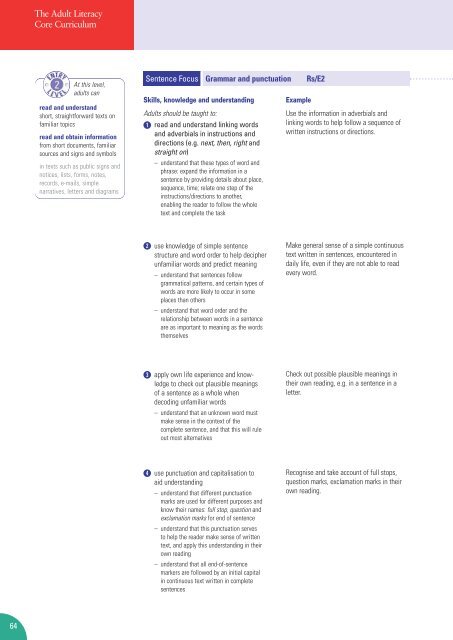Adult Literacy Core Curriculum - Nationally developed Skills for Life ...
Adult Literacy Core Curriculum - Nationally developed Skills for Life ...
Adult Literacy Core Curriculum - Nationally developed Skills for Life ...
Create successful ePaper yourself
Turn your PDF publications into a flip-book with our unique Google optimized e-Paper software.
64<br />
The <strong>Adult</strong> <strong>Literacy</strong><br />
<strong>Core</strong> <strong>Curriculum</strong><br />
At this level,<br />
adults can<br />
read and understand<br />
short, straight<strong>for</strong>ward texts on<br />
familiar topics<br />
read and obtain in<strong>for</strong>mation<br />
from short documents, familiar<br />
sources and signs and symbols<br />
in texts such as public signs and<br />
notices, lists, <strong>for</strong>ms, notes,<br />
records, e-mails, simple<br />
narratives, letters and diagrams<br />
Sentence Focus Grammar and punctuation Rs/E2<br />
<strong>Skills</strong>, knowledge and understanding<br />
<strong>Adult</strong>s should be taught to:<br />
1 read and understand linking words<br />
and adverbials in instructions and<br />
directions (e.g. next, then, right and<br />
straight on)<br />
– understand that these types of word and<br />
phrase: expand the in<strong>for</strong>mation in a<br />
sentence by providing details about place,<br />
sequence, time; relate one step of the<br />
instructions/directions to another,<br />
enabling the reader to follow the whole<br />
text and complete the task<br />
2<br />
3<br />
4<br />
use knowledge of simple sentence<br />
structure and word order to help decipher<br />
unfamiliar words and predict meaning<br />
– understand that sentences follow<br />
grammatical patterns, and certain types of<br />
words are more likely to occur in some<br />
places than others<br />
– understand that word order and the<br />
relationship between words in a sentence<br />
are as important to meaning as the words<br />
themselves<br />
apply own life experience and knowledge<br />
to check out plausible meanings<br />
of a sentence as a whole when<br />
decoding unfamiliar words<br />
– understand that an unknown word must<br />
make sense in the context of the<br />
complete sentence, and that this will rule<br />
out most alternatives<br />
use punctuation and capitalisation to<br />
aid understanding<br />
– understand that different punctuation<br />
marks are used <strong>for</strong> different purposes and<br />
know their names: full stop, question and<br />
exclamation marks <strong>for</strong> end of sentence<br />
– understand that this punctuation serves<br />
to help the reader make sense of written<br />
text, and apply this understanding in their<br />
own reading<br />
– understand that all end-of-sentence<br />
markers are followed by an initial capital<br />
in continuous text written in complete<br />
sentences<br />
Example<br />
Use the in<strong>for</strong>mation in adverbials and<br />
linking words to help follow a sequence of<br />
written instructions or directions.<br />
Make general sense of a simple continuous<br />
text written in sentences, encountered in<br />
daily life, even if they are not able to read<br />
every word.<br />
Check out possible plausible meanings in<br />
their own reading, e.g. in a sentence in a<br />
letter.<br />
Recognise and take account of full stops,<br />
question marks, exclamation marks in their<br />
own reading.

















